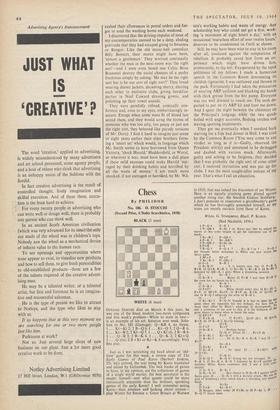Chess
By PHILIDOR No. 186. 0. STOCCHI (Second Prize, L'I(alia Scacchistica, 1958)
BLACK (3 men) WHITE (6 men) OTTAVIO STOCCH1 died on March 4 this year; he was one of the finest modern two-move composers and this week's problem—White to mate in two— is an example of his art. Solution next week. Solu- tion to No. 185 (Gamage): Q—KB 4, no threat. 1 ... Kt—Kt 2; 2 B—Q 6.-1 Kt—Q 3; 2 Q—R 6. 1 ... Kt—B 2; 2 Kt—Q 7. 1 Q x Kt ch; 2 B—B 4..
1 . . . Q—B 3; 2 B—K 6. 1 . . . Q—K 2; 2 Kt x Q. 1 . . . Q else; 2 R x Kt or Kt—K 6 accordingly. Very fine play.
Just as 1 was scratching my head about an 'old- time' game for this week, a review copy of The Early Games of Paul Keres (Herbert Jenkins, 27s. 6d.) arrived, the text being by Keres translated and edited by Golombek. The best books of games to have, in my opinion, are the collections of games of a single world master, the best annotator is the master himself—and what games could be more intrinsically enjoyable than the brilliant, sparkling games of the early Keres? I well remember seeing Keres—then nineteen and looking about sixteen— play Winter for Estonia v. Great Britain at Warsaw in 1935; that was indeed the discontent of our Winter. Here is an equally crushing game played against another rising star, the Swedish Gideon Stahlberg: I don't presume to reannotate a grandmaster's game which he has thoroughly annotated himself, so tnY notes are merely extracts from those of Keres.
White, G. STAHLBERG. Black, P. KERBS. (Bad Nauheim, 1936.)
1 P—Q 4 P—K 3
2 P—QB 4 B—Kt 5 ch. Keres says that he played th°
moves in this order largely to get his opponents out of the
43PK—t—KB33
books. P—QB 4 Kt—KB 3 5 P—QR 3 B xKt ch 6 P x13 0-0
7 B—Q 3 P—Q 4. 7 . . . Kt—B 3 or 7 . P—Q 3 are thought better nowadays as White can now secure tio better game.
8 BP xP KP xP 9 Kt—K 2 P—QKt 3 100-0 B—R 3
11 B—B 27 . .. It is known now that 11 P—B 2' BXB; 12 Q X B, R—K 1; 13 Kt—Kt 3, Kt—B 3; 14 B—Kt 2 followed by QR—K 1 gives White a promising position.
11 . . Kt—B3
12 R—k 1 . . . Better 12 P—B 3 and then R—B 2;
the rook has no future on K 1.
12 R—K 13 3:–.13 3 R--QB 1 14 PXP/ . . . White should either play 14 Kt—Kt 3. PXP; 15 BPXP, KtxP; 16 BXP ch. KX13; 17 QxKt else 14 B—Q 1 admitting the error of B—B 2.
14 . . . P x P 15 Kt—Kt 3 P—Q 51 Usually it is bad to open tiP game when the opponent has two bishops, but here this„,.'„ more than offset by Black's advantage in development. add a comment of my own to this, it Is the halimark,of tw" great player to know when to break the rules.
16 KPxP P xP
17 RXR ch .. 17 13XP?, QXP chi: 18 ••. 11–
5eQ
Rxa ch; 19 K—B 2:Kt XQ winning. 17 Q x R
is i.;P KtxP
19 B—R 4 Nothing better.
19 . . . 0—K 4! Threat 20 . . . KtxP eh 20 K—Kt 1 Kt—Q 4!
21 B—Kt 2 . . . Or 21 Kt—K 4, B—K 7 and 22 • ' BxPI 21 ..Kt—B 6 22 B x kt R xB
23 K—R 1 . . . To meet 23 . . . R xRP?; with
24 Q X Kt.
23 P—R 4!
24 11-. 7 R—Q 6? Strong but not strongest. 24 • ;,,; P—R 5; 25 Kt—K 4, B—K 7 followed by KtxP quicklY molishes White. Keres comments that '1 was a little ove' excited.'
25 Q—R 4 B—Kt 2
26 Kt—K 41 . . Best chance is 26 Q—B 4 against w Keres•gives 26 . . . Q—K 6 with a decisive attack. We can .71-1 glad of Stahlberg's error which allows a charming and urlusu finish.
26B x Kt 27 '3 Kt—l36?
28 Resigns. After either 28 PXKt or 28 P—Kt 3, ZS . R—Q 71 forces mate.










































 Previous page
Previous page